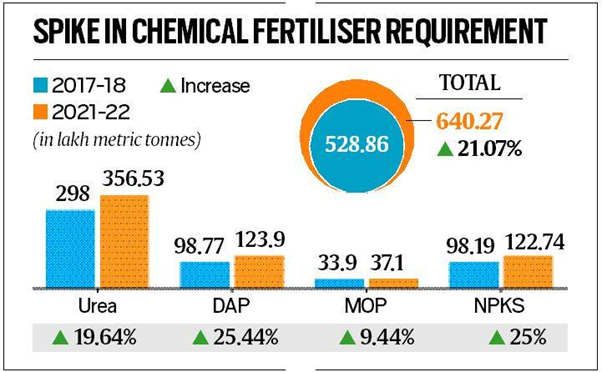

19th September 2022 (7 Topics)
Context
The Union government intends to launch a scheme — named PM PRANAM — to reduce the use of chemical fertilizers by incentivising states.
About
What is in the proposed scheme?
- PM PRANAM is short for PM Promotion of Alternate Nutrients for Agriculture Management Yojana.
- The scheme aims to:
- to reduce the use of chemical fertilisers
- to bring down the subsidy burden on chemical fertilisers, which is estimated to reach Rs 2.25 lakh crore in 2022-23 — 39 per cent higher than last year’s figure of Rs 1.62 lakh crore.
- The move is in line with the government’s focus on promoting a balanced use of fertilisers or alternative fertilisers in the last few years.

About Indian Fertilizer Sector
- Indian soils are generally deficient in nitrogen, phosphorus, and potassium and do not give high yields. Hence, the need for fertilizers.
- Green Revolution (Use of chemical fertilizers was one component) has made a significant impact on Indian agriculture.
- Thus, India was able to achieve self-sufficiency in food production.
- Fertilizer Manufacturing Sectors
- Fertilizer Manufacturing Companies (PSUs): National Fertilizers Limited, Rashtriya Chemicals & Fertilizers Limited, etc
- Fertilizer Manufacturing Co-operatives: IFFCO, KRIBHCO, etc
- Position in the World: 3rd in terms of production and 2nd in terms of consumption
- Decision-Making Body: Department of Fertilizers, Ministry of Chemicals & Fertilizers, Govt of India
|
Important Government Initiatives and Schemes
- “One Nation One Fertiliser” scheme: The scheme would be done by introducing a “Single Brand for Fertilisers and Logo” under the fertiliser subsidy scheme named “Pradhanmantri Bhartiya Janurvarak Pariyojna” (PMBJP).
- The scheme would extend to all four fertilisers – Urea, Di-Ammonium Phosphate, Muriate of Potash and complex NPK – with BHARAT pre-fixed.
- Neem Coating of Urea: The Department of Fertilizers (DoF) has made it mandatory for all the domestic producers to produce 100% urea as Neem Coated Urea (NCU).
- New Urea Policy (NUP) 2015: Objectives of the policy are-
- To maximize indigenous urea production.
- To promote energy efficiency in the urea units.
- To rationalize the subsidy burden on the Government of India.
- New Investment Policy- 2012: The Government announced New Investment Policy (NIP)-2012 in January, 2013 and made amendments in 2014 to facilitate fresh investment in the urea sector and to make India self-sufficient in the urea sector.
- Policy on Promotion of City Compost: The Government of India approved a policy on promotion of City Compost, notified by the DoF in 2016 granting Market Development Assistance of Rs. 1500/- for scaling up production and consumption of city compost.
- Nutrient Based Subsidy (NBS) Scheme: It has been implemented from April 2010 by the DoF. Under NBS, a fixed amount of subsidy decided on an annual basis, is provided on each grade of subsidized Phosphatic & Potassic (P&K) fertilizers depending on its nutrient content.

